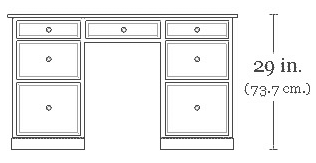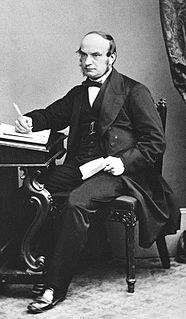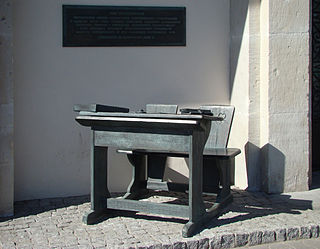
Furniture refers to movable objects intended to support various human activities such as seating, eating (tables), and sleeping. Furniture is also used to hold objects at a convenient height for work, or to store things. Furniture can be a product of design and is considered a form of decorative art. In addition to furniture's functional role, it can serve a symbolic or religious purpose. It can be made from many materials, including metal, plastic, and wood. Furniture can be made using a variety of woodworking joints which often reflect the local culture.

A notebook is a book or stack of paper pages that are often ruled and used for purposes such as recording notes or memoranda, other writing, drawing or scrapbooking.

One of the basic pieces of furniture, a chair is a type of seat. Its primary features are two pieces of a durable material, attached as back and seat to one another at a 90° or slightly greater angle, with usually the four corners of the horizontal seat attached in turn to four legs—or other parts of the seat's underside attached to three legs or to a shaft about which a four-arm turnstile on rollers can turn—strong enough to support the weight of a person who sits on the seat and leans against the vertical back. The legs are typically high enough for the seated person's thighs and knees to form a 90° or lesser angle. Used in a number of rooms in homes, in schools and offices, and in various other workplaces, chairs may be made of wood, metal, or synthetic materials, and either the seat alone or the entire chair may be padded or upholstered in various colors and fabrics.

An armoire desk is a writing-table built within a large cabinet, usually 1.5–2.0 metres high. The cabinet is closed by two to four full-height doors, to keep out dust or to give a tidy appearance to a room by hiding the cluttered working surface of the desk. This form of desk is usually placed against a wall, like its antique uncle, the secretary desk.

A desk or bureau is a piece of furniture with a flat table-style work surface used in a school, office, home or the like for academic, professional or domestic activities such as reading, writing, or using equipment such as a computer. Desks often have one or more drawers, compartments, or pigeonholes to store items such as office supplies and papers. Desks are usually made of wood or metal, although materials such as glass are sometimes seen.

A pedestal desk or a tanker desk is usually a large, flat, free-standing desk made of a simple rectangular working surface resting on two pedestals or small cabinets of stacked drawers of one or two sizes, with plinths around the bases. Often, there is also a central large drawer above the legs and knees of the user. Sometimes, especially in the 19th century and modern examples, a "modesty panel" is placed in front, between the pedestals, to hide the legs and knees of the user from anyone else sitting or standing in front. This variation is sometimes called a "panel desk". The smaller and older pedestal desks with such a panel are sometimes called kneehole desks, and were usually placed against a wall.

A writing table has a series of drawers directly under the surface of the table, to contain writing implements, so that it may serve as a desk. Antique versions have the usual divisions for the inkwell, the blotter and the sand or powder tray in one of the drawers, and a surface covered with leather or some other material less hostile to the quill or the fountain pen than simple hard wood.

There are two kinds of trestle desk: as with trestle tables, some have trestles joined by one or more stretchers, and some have free-standing trestles. They can be dismantled, with the desk top removed from the trestles, for storage or transport.

A Davenport desk, is a small desk with an inclined lifting desktop attached with hinges to the back of the body. Lifting the desktop accesses a large compartment with storage space for paper and other writing implements, and smaller spaces in the forms of small drawers and pigeonholes. The Davenport has drawers on one of its sides, which are sometimes concealed by a panel. This stack of side drawers holds up the back of the desk and most of its weight.
The lap desk is a desk set in the lap. In the European tradition, it can be considered a modern form of the portable desk.
A field desk is a portable desk which is meant to be used in rear areas near a battlefield and moved around rather frequently in difficult conditions. It is in contrast to the campaign desk, which is usually heavier and meant for areas further in the rear.

A Desk and bench can be an antique or a modern form of desk combined with a small bench or a stool made in exactly the same style and material. The desk is usually not very big and meant to be placed against a wall, in a little room or a hallway. Because of this intended venue and its small size it is in a sense a cousin to the telephone desk. In form it is in general a smaller brother of the writing table.

An office chair, or desk chair, is a type of chair that is designed for use at a desk in an office. It is usually a swivel chair, with a set of wheels for mobility and adjustable height. Modern office chairs typically use a single, distinctive load bearing leg, which is positioned underneath the chair seat. Near the floor this leg spreads out into several smaller feet, which are often wheeled and called casters. Office chairs were developed around the mid-19th century as more workers spent their shifts sitting at a desk, leading to the adoption of several features not found on other chairs.

A tablet computer, commonly shortened to tablet, is a mobile device, typically with a mobile operating system and touchscreen display processing circuitry, and a rechargeable battery in a single, thin and flat package. Tablets, being computers, do what other personal computers do, but lack some input/output (I/O) abilities that others have. Modern tablets largely resemble modern smartphones, the only differences being that tablets are relatively larger than smartphones, with screens 7 inches (18 cm) or larger, measured diagonally, and may not support access to a cellular network.
Picnic with Weissmann is a 1968 Austrian animated short film by Jan Švankmajer.

A stool is one of the earliest forms of seat furniture. It bears many similarities to a chair. It consists of a single seat, for one person, without back or armrests, on a base of a stool there are either one, two, three or four legs. A stool is generally distinguished from chairs by their lack of arms and a back. Variants exist with one, two or five legs and these various stools are referred to by some people as "backless chairs". Some modern stools have backs. Folding stools can become flat, typically by rotating the seat to be parallel with fold-up legs.

The furniture of the Louis XV period (1715-1774) is characterized by curved forms, lightness, comfort and asymmetry; it replaced the more formal, boxlike and massive furniture of the Style Louis XIV. It employed marquetry, using inlays of exotic woods of different colors, as well as ivory and mother of pearl.

Louis XIV furniture was massive and lavishly covered with sculpture and ornament of gilded bronze in the earlier part of the personal rule of King Louis XIV of France (1660–1690). After about 1690, thanks in large part to the furniture designer André Charles Boulle, a more original and delicate style appeared, sometimes known as Boulle Work. It was based on the use of marquetry, the inlay of piece of ebony and other rare woods, a technique first used in Florence in the 15th century, which was refined and developed by Boulle and others working for the King. Furniture was inlaid with thin plaques of ebony, copper, mother of pearl, and exotic woods of different colors in elaborate designs.

Louis XVI furniture is characterized by elegance and neoclassicism, a return to ancient Greek and Roman models. Much of it was designed and made for Queen Marie Antoinette for the new apartments she created in the Palace of Versailles, Palace of Fontainebleau, the Tuileries Palace, and other royal residences. The finest craftsmen of the time, including Jean-Henri Riesener, Georges Jacob, Martin Carlin, and Jean-François Leleu, were engaged to design and make her furniture.

















